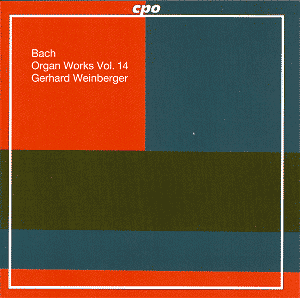Arrangements were a common phenomenon in the
18th century. All sorts of compositions were arranged, transcribed
or transposed. Bach was no exception: he arranged his own works
and the compositions of those of his contemporaries that he admired.
But his own works were also arranged by others.
This recording, volume 14 in a series with the
complete organ works by Bach, is devoted to the kind of arrangements
mentioned above. Here we find two of Bach's transcriptions of
instrumental concertos by Antonio Vivaldi (BWV 594) and Johann
Ernst von Sachsen-Weimar (BWV 595) respectively. The other arrangements
are by unknown authors - only the Prelude and fugue in d minor
(BWV 539) is likely to be written by Bach. In this work the prelude
- for manuals without pedal - is the only original piece on this
CD. The following fugue is an arrangement of the second movement
of Bach's Sonata for violin solo No. 1 (BWV 1001). The Trio in
b minor (BWV 790) is an arrangement of the 3-part Invention or
Sinfonia in d minor, the Fugue in g minor (BWV 131) was made after
the concluding fugue of the Cantata 'Aus der Tiefen' (BWV 131).
The Sonata in G (BWV 1027a) consists of three movements from the
Sonata for viola da gamba and harpsichord (BWV 1027) and the trio
sonata for two transverse flutes and basso continuo (BWV 1039).
It has been completed by Gerhard Weinberger, who has transcribed
the third movement (andante). And the Trio in d minor (BWV 585)
is a transcription of two movements from a trio sonata for 2 violins
and basso continuo by Johann Friedrich Fasch. One could ask why
this piece has been recorded - apart from the fact that it is
included in Schmieder's catalogue - since it is not at all certain
that Bach has made the arrangement. That is also the case with
the Trio in G (BWV 586): the original is a keyboard piece by Telemann,
the author of the arrangement is unknown.
The fact that it is often unclear whether the
author of an arrangement was Bach himself or someone else is no
surprise. As a composer of sacred vocal music Bach may not have
enjoyed universal admiration, his reputation as organist and composer
of organ music was sky-high. He was much sought after as organ
teacher. And his pupils held him in such high esteem that they
often copied his style. Many of the arrangements come from "Bach's
immediate circle". This CD gives an interesting insight into the
world of the organist, organ teacher and organ composer Bach and
the circle of his pupils.
Gerhard Weinberger is committed to the historical
performance practice. He has chosen a historical organ from Bach's
time. His phrasing and articulation reflect what is known about
the habits in Germany in the first half of the 18th century.
A commitment to the historical performance practice
doesn't guarantee a convincing performance, though. Yes, some
pieces are well played, for example the Trio in G (BWV 586): lively
and well articulated, in a very well chosen registration. But
on the whole I am disappointed by the performance of Gerhard Weinberger.
One of the main problems is the registration.
Many organists seem to think the concerto arrangements ask for
a opulent registration. But baroque concertos are not 'orchestral'
works in the sense of the classical or romantic symphony, but
rather chamber works for a limited number of instruments. The
concertos played here contain a lot of passage work. The articulation
in these passages is insecure or even sloppy - at least, that
is how it sounds. A more moderate registration would have allowed
a much more secure articulation. Another problem in this regard
is the registers used for the solo passages. Weinberger makes
a clear difference between the soli and the tutti. That would
be right if the solo part was originally written for a transverse
flute or an oboe. But the Concerto in C (BWV 594) is an arrangement
of Vivaldi's Concerto for violin, strings and b.c. in D (RV 208),
nicknamed 'Il Grosso Mogul'. There is no differentiation in colour
between the solo instrument and the 'orchestra' and the registration
should reflect this. The different colour of the registration
for the solo part here undermines the natural balance between
solo and tutti.
Where a composition consists of several movements,
Weinberger usually changes the registration from one movement
to the other. That breaks up the coherence of these pieces. The
Sonata in G (BWV 1027a) is a good example.
But there is more. Take the Fugue in d minor
(BWV 539), for instance. There is a lack of differentiation between
the various sections and between single notes. When a note is
repeated several times, like in the theme of the fugue, all notes
are played the same way, without any difference in length. More
differentiation between notes, but also breathing spaces and more
rubato here and there would have created greater tension and a
more rhetorical and gestural performance.
One of the intriguing aspects of Bach’s Concerto
transcriptions is the fact that he has been able to keep the dramatic
character of the original concertos alive – in particular in Vivaldi’s
‘Grosso Mogul’. But in this performance there is hardly any drama
left and the ‘swing’ which characterises Vivaldi’s Concertos is
completely lost here. And the middle movement of the Concerto
BWV 594 is described by Vivaldi as 'recitativo', which indicates
a rhythmically free interpretation - something Weinberger seems
to have overlooked.
This is the first volume of the series I have
heard, therefore I can’t tell whether this one is representative
of the entire series. I certainly hope not, because this CD hasn’t
satisfied me at all.
Johan van Veen
